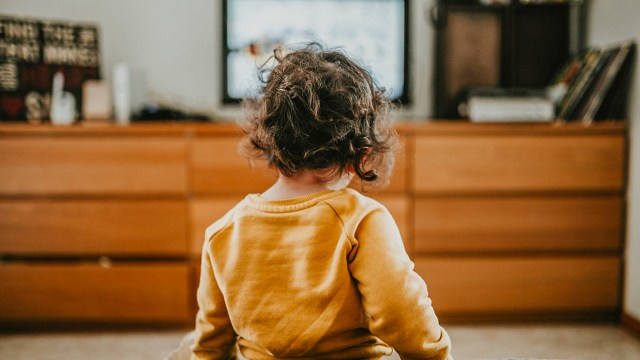We all know that screen time for toddler-aged kids should be limited, but let’s be real, sometimes we need to make dinner, clean the house, or kill some time while waiting at the pediatrician’s office. The American Academy of Child and Adolescent Psychiatry offers the following screentime guidelines:
- Between 18 and 24 months, screen time should be limited to watching educational programming with a caregiver.
- For children 2-5, limit non-educational screen time to about 1 hour per weekday and 3 hours on weekend days.
Instead of beating ourselves up for allowing our kids to watch a show, speech-language pathologist Moira Chrzanowski suggests that we take the opportunity to help our little ones develop their language skills. “For the most part in that zero to five age range, verbal language skills should be your top priority as far as education goes, and that includes listening and speaking skills.”
@rooted.in.language Don’t come at me, Bluey fans! #rootedinlanguage #parenting #toddlertips #speech #languagedevelopment #learningtotalk #learningwords #firstwords #screentime #slp #speechtherapist #speechdelay #speechtips #parentingtips #toddlerparents #peppapig #danieltiger #msrachel
♬ original sound – Nintendo – Nintendo
Some shows do a much better job at teaching these skills, Chrzanowski explains on her TikTok account @rooted.in.language. “When choosing media that’s going to be high quality for your kid, you need to intentionally choose based on what’s age appropriate that hits that zone of proximal development… that means they’re actually able to engage and learn, not [something] that’s way above their head so they disengage and become passive listeners.”
These are the three shows she recommends and why they are so great:
- Miss Rachel: “She expertly employs a parentese, child-directed style of speaking. She specifically targets the articulation of speech sounds and vocabulary building. She shamelessly exploits the power of song and repetition to great effect, and she explicitly teaches vocabulary and scripts for functional social routines and common activities—things like getting dressed for different weather, bedtime, playground play, going to the zoo, going to a birthday party. All of these strategies target big, complex skills and target them well, making her show the ‘chef’s kiss’ for having an actual impact on language development,” Chrzanowski says.
- Peppa Pig: “What I like about Peppa is the short and relatable story arcs, shorter than Bluey. Yes. Bluey episodes aren’t long, but they’re too long for a lot of two-year-olds. And a lot of the Bluey topics are complex, which mostly go over a two-year-old’s head and therefore don’t hold their attention,” Chrzanowski explains. “Peppa Pig episodes are under five minutes long. They’re simple, they’re happy, they’re the kind of plots a two-year-old can begin to follow… The best part about Peppa Pig for building language skills is the slow rate of speech. The dialogue and narration in Peppa Pig is noticeably slower than your average rate of speech.”
- Daniel Tiger: “The best feature of Daniel Tiger is its use of short repeated songs to address daily feelings, problems, and experiences. I’m talking [about] little ditties that are 10 seconds or less. Each little melody surrounds a particular theme and is repeated frequently across a single episode,” Chrzanowski says. “This aspect of Daniel Tiger is the main reason I find it so effective for building language skills—because it hits two key checkpoints for language learning: memory and motivation. Memorable because of the short, repetitive, catchy tunes a lot like commercial jingles. Motivating because the topics are highly relevant and immediately applicable to toddlers’ little lives.
So there you have it! The next time you need to pull out a screen, cut yourself some slack and remember that you’re helping them become better communicators in every way possible.











